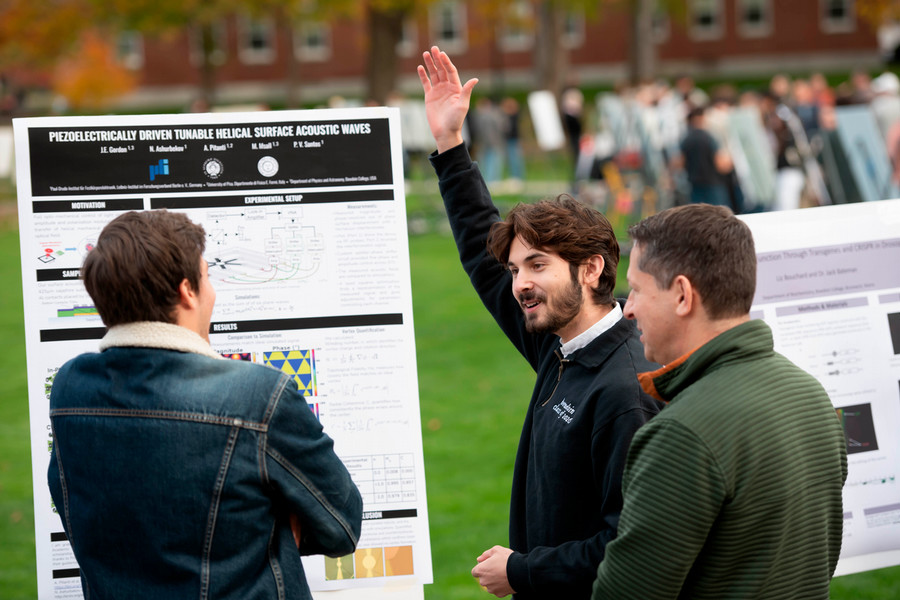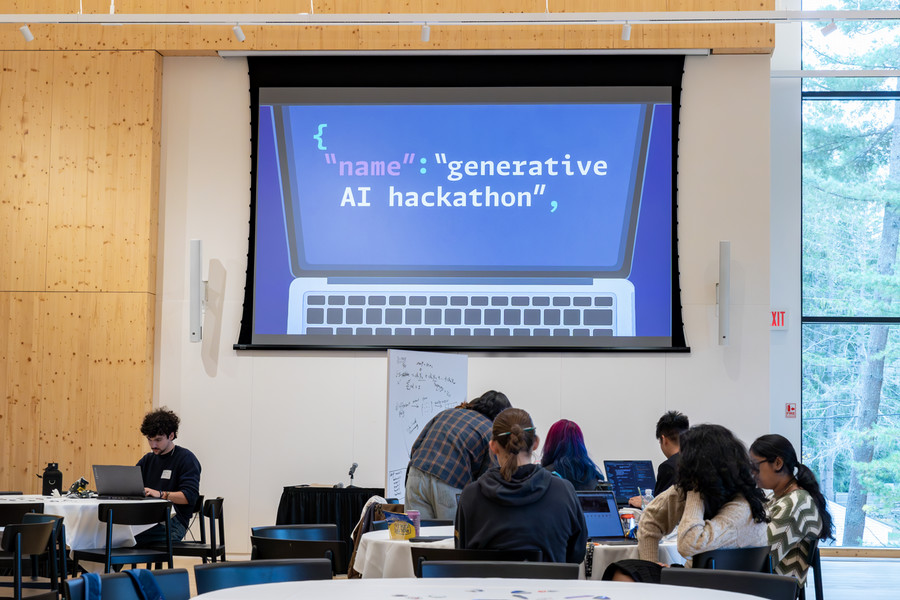Mingi Kang ’26: Advancing Computers' Ability to See and Understand Our World
By Rebecca GoldfineMingi Kang ’26 received a Fall Research Award from Bowdoin this semester to support his project exploring how two distinct concepts for computer vision might be combined to create a more robust artificial intelligence.

This profile is the first in a series on students who have received fall research awards to pursue faculty-mentored, independent projects.
When Kang, a math and computer science major, first arrived at Bowdoin from Los Angeles, he wanted to study cognitive science. During his first two years here, he assisted a psychology professor with her long-term research into how we search for and retrieve information from our memory. (Read more about their study.)
For that work, he leaned on his Python programming skills, until over time he realized he was more drawn to computer cognition than human cognition. “I wanted to make that switch from cognitive science more directly to computer science,” he said.
When Kang discovered that Assistant Professor of Computer Science Jeová Farias was researching computer vision, he reached out to see if he could join his study. Farias agreed to mentor him, and the summer after his sophomore year, Kang was awarded a Christenfeld Research Fellowship from Bowdoin's Office of Student Fellowships and Research to assist him.
“I didn’t have any specific experience in computer vision, but I always thought of it as interesting, and I thought it would be a great opportunity to get hands-on experience with a real-world problem,” Kang said.
Farias said that as a liberal arts professor, he aims to provide undergraduates with research opportunities in AI or computer vision “that go beyond just developing new method that improve some—sometimes quite arbitrary—performance metrics. My goal is learning what really goes on underneath these complicated methods.”
Each fall, the Student Fellowships and Research office awards grants for up to $2,500 to students pursuing research for independent studies or honors projects during the academic year.
The awards are supported by endowed funds set up by donors who wish to enable faculty-mentored research across the disciplines.
This year, the office gave awards to thirty-four students majoring in Africana studies, anthropology, biology, chemistry, classics, computer science, digital and computational studies, earth and oceanographic science, education, English, environmental studies, government, history, neuroscience, or Romance languages.
Seeing is Believing
To explain the details of his senior-year honors project, called “Attention Via Convolutional Nearest Neighbors,” Kang pulled out a piece of paper from his notebook and began sketching a box divided into smaller boxes.
His diagram showed how convolutional neural networks work. An earlier generation of technology, convolutional neural networks (Kang refers to them simply as convolution) enable computers to recognize objects and faces—giving them “sight.”
Convolution works by creating smaller blocks to learn the relationships between the data within each block. When processing an image using convolution, for instance, a computer divides it into smaller windows to scan one by one, deciphering how the pixels in each chunk relate to one another. “It’s like a magnifying glass focusing on a smaller section at a time,” Kang said. “At the end, it’s able to understand an image holistically.”
But this approach has been superseded by a newer method called self-attention from natural language processing, giving computers the power to read and write in ways that mimic the human mind. “It’s one of the big breakthroughs of the last decade,” Kang said. “It’s the transformer architecture used in ChatGPT and all the artificial intelligence models we use today.”
Self-attention works very differently than convolution. Rather than scanning small segments, the computer analyzes the relationships between every word to all other words in a sentence, paragraph, or larger text. “It is not bound by a local lens, but can learn the interconnections and understand the entire structure,” Kang said.
Though convolution is used primarily for images and self-attention is used primarily for text, Kang is studying how they can intersect. “The end goal is to get them working together,” he said. “Convolution was one of the biggest things in computer vision and natural language processing from the early 2000s to 2017, and then in came the attention mechanism, which is thought of as a newer and better thing.”
Still, he believes the two approaches can augment one another. “If we get them working together, it can benefit both—taking all the great qualities of one side and bringing them to the other. We will have a stronger model by combining a local convolution model with a global attention model,” he said.
Farias added that their project reveals “that both mechanisms admit a shared formulation: they can be interpreted as particular instantiations of a classical machine learning algorithm called K-nearest neighbors."
He praised Kang's contribution. “Mingi has helped me in many ways [with] this project. He has been a great research assistant throughout!”
Kang and Farias are submitting a co-written paper on their research to a computer vision conference. Kang's grant will help cover his travel costs to present this work.
Kang plans to continue studying computer science in graduate school next year. “I love doing this because this work can be used in multiple disciplines—psychology, health, medicine, or the environment,” making computer science a truly interdisciplinary undertaking and one that can potentially solve many different problems, he said.
Among many great classes, Kang said he particularly enjoyed the following three:
- Fundamentals of Music, with Jeffrey Christmas. “That class was very engaging!” Kang said. The course explored form, harmony, melody, pitch, rhythm, texture, and timbre, and taught reading and writing Western music notation for the purposes of reading, analyzing, and creating musical works.
- Artificial Intelligence, with David Byrd. “I liked it because it was my first introduction to machine learning and artificial intelligence, the research I am doing now,” Kang said. The class explores state-space and heuristic search techniques, logic and other knowledge representations, reinforcement learning, neural networks, and other approaches.
- Advanced Topics in Probability and Statistics, with Jack O’Brien. “He teaches it more like a graduate seminar, and it really dives deeply into advanced techniques in statistics,” Kang said. Topics taught include regression analysis, nonparametric statistics, logistic regression, and other linear and nonlinear approaches to modeling data.


